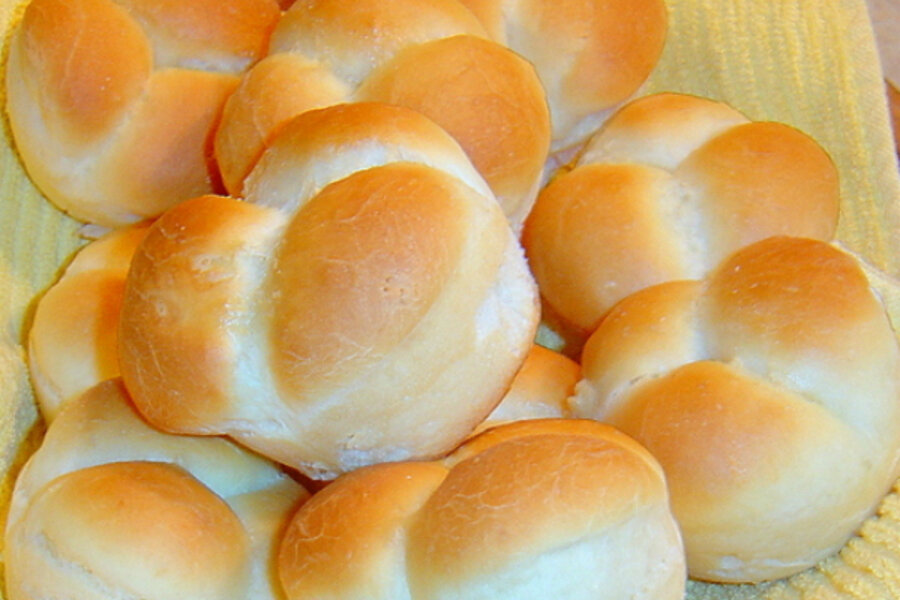Thanksgiving cloverleaf rolls
Loading...
We love having these tasty dinner rolls on occasions like Sunday dinner or at Thanksgiving or Christmas when we have guests.
I use White Lily flour in this, which is formulated from soft winter wheat, and has a lower protein content and is also lower gluten. White Lily is generally sold in the southern United States (although I can find it at one market where I live – check around!) Other choices besides using White Lily are using Swans Down cake flour or King Arthur’s Guinivere Cake flour. A cheater’s method for making softer flour is that for every cup of all-purpose flour you want to use, remove 3 tablespoons of the flour and replace it with either corn starch or potato starch. So there should be something you can find, no matter where you are.
There are also a few bread baking tips I would like to share with you!
First, about the water temperature. When you are using yeast, you need to have a range of temp for the water. Too cold and the yeast will not eat sugar. Too hot and you will kill off the yeast. And since the yeast eat the little bit of sugar in your dough, fell gassy, then, eh, ahem, “burp” that gas, it causes the bread to rise. I keep my water that I add to the flour between 110-120 degrees F.
I also use an electric stand mixer to mix my dough but you can use the dough cycle on your bread machine or your food processor if it suits you. I find I have best results with the stand mixer so while I keep my food processor busy with other kitchen tasks, the bread machines have gone the way of the dinosaur in my house. The stand mixer is a worthwhile investment if you can afford it. It is a workhorse and can even mix your meatloaf for you besides other wonderful things like making stiff egg whites or whipped cream. And bread machine recipes are easy enough to translate to the mixer, and vice versa. The mixer is like the dough cycle on a bread machine. From there, you can even turn the dough out of a bread machine and put it into a bread pan, let it rise, then bake. When making rolls, it has to come out of the bread machine anyway, at which point you cut the dough, roll into desired shapes, and let it rise on a baking sheet before popping into the oven.
I have a couple other tricks – you will read about them when reading through the prep method the first time.
Cloverleaf dinner rolls
1 cup warm water (110 degrees F.)
2 (1/2 ounce) envelopes active dry yeast
1/2 cup unsalted butter, melted and cooled to room temperature
1/2 cup sugar
3 eggs, lightly beaten, at room temperature
1 teaspoon salt
5-1/2 cups all-purpose, soft winter wheat flour (White Lily, or see note above)
1. In the steel bowl of your stand mixer, place a bunch of hot water to warm the bowl while you get ingredients together. Place an instant read thermometer in the water while you get your ingredients together.
2. When you see the temperature is between 110-120 degrees F, drain off all the water except 1 cup.
3. Add the yeast, the room temperature melted butter, sugar, room temperature eggs, and salt.
4. Add dough hook and run mixer on low, adding flour 1/2 cup at a time until dough comes together, adjusting flour amount if necessary, then run mixer until dough is fairly smooth. And by this I mean the dough should not try to crumble. And it should be a little bit tacky, but have come together totally. It shouldn’t be really wet either. Since humidity and other factors can change how your dough is, you may need to tinker by adding flour a tablespoon at a time, sprinkling over the dough, or even adding water the same way, dunking your fingers into warm water and flicking it at the dough until it comes together nicely.
5. Turn dough out into an oiled bowl, cover with plastic wrap, and refrigerate for 2 hours.
6. Turn dough out onto a lightly floured surface. Divide dough in half, then each half into 4 pieces, then each piece into thirds. Roll each piece into a log and cut into three more pieces, and roll in between lightly oiled hands into smooth balls.
7. Grease a muffin tin and place three balls into each cup. Cover loosely with plastic wrap and let sit in a warm, draft-free place for several hours or until doubled in size. I often put an orthopedic heating pad underneath the muffin pan and turn it on if the room seems cool. I have even done this in summer and it works like a charm.
8. Bake at 375 degrees F for 12-15 minutes, or until golden brown






